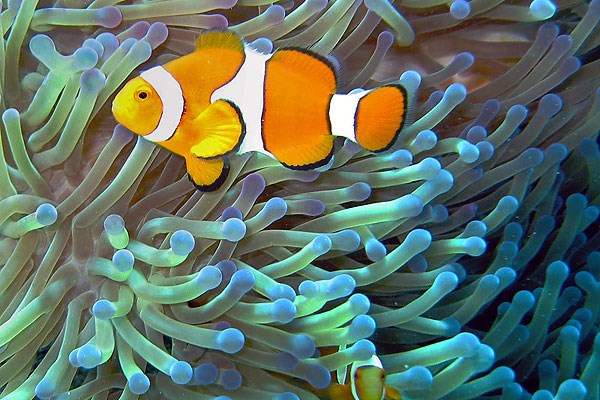Student’s Work Is Part of International Academic Exchange Program
 Image by Jan Derk/Wikimedia Commons
Image by Jan Derk/Wikimedia Commons
Sea anemones have a symbiotic relationship with the common clownfish – the anemones’ venom-filled tentacles give the fish protection from predators, while the anemone snacks on food scraps from the clownfish’s meals.
08/01/2017
By Edwin L. Aguirre
Can the venom from the sea anemone be used to fight cancer cells in humans?
That’s what a visiting student researcher from Spain wanted to find out during her recent internship at UMass Lowell.
Esperanza Rivera de Torre, a biology Ph.D. candidate from the Universidad Complutense de Madrid (UCM), spent three months working in the lab of Assoc. Prof. Jessica Garb in the Department of Biological Sciences, investigating the cancer-fighting potential of the sea creatures.
Sea anemones, which are ornately colored marine invertebrates, spend their lives attached to rocks on the sea bottom or to coral reefs. Close relatives of coral and jellyfish, they have tentacles filled with stinging polyps that can inject paralyzing neurotoxin into their prey, usually small fish or crustaceans. Those toxins offer possible clues on how to effectively target and destroy cancerous cells.
 Image by Edwin L. Aguirre
Image by Edwin L. Aguirre
Biology Assoc. Prof. Jessica Garb, left, and ERASMUS exchange student Esperanza Rivera de Torre load samples into the DNA sequencer at the university’s Biomolecular Characterization Lab in the Saab Center on North Campus.
“The venom from sea anemones can produce a burning sensation. It can be painful like a jellyfish sting, but not enough to kill people,” says Rivera. “I use the genetic engineering tools available in the lab to analyze the toxic proteins from Caribbean sea anemones and try to figure out how they work. These toxins can create holes in the walls of any cells. In this case, we’d like the toxins to target malignant cells.”
In addition to working in the lab with Garb, Rivera also spent time with Jack Lepine, a technician in the university’s Biomolecular Characterization Lab at the Saab Center.
“There, she used the Core Research Facility’s new next-generation DNA sequencer to learn new techniques of collecting high-throughput gene-expression data and bioinformatics,” says Garb.
 Image by Edwin L. Aguirre
Image by Edwin L. Aguirre
Rivera works with Jack Lepine, a technician in the Biomolecular Characterization Lab.
“So far, the results look promising,” notes Rivera.
Expanding Knowledge Globally
Rivera’s research on campus was part of the ERASMUS program, a student-exchange initiative launched in 1987 by the European Union. Currently, more than 4,000 institutions of higher learning across 37 countries participate in the program, and more than three million students had taken part since its inception.
“I’ve had a really good experience at UMass Lowell,” says Rivera, who expects to finish her doctorate in 2020.
“I learned about American culture, learned how to work with new research groups – a skill I will need in the future – and I was able to practice my English, the language of the sciences. I was also able to gain access to laboratory tools that are not available in my home country and learned bioinformatics, which are computational tools for analyzing large data sets. These are a big plus to my thesis,” she says.
“It was great to have Esperanza in my lab,” says Garb. “She had lots of energy and enthusiasm and got along very well with other people in my research group.”
Like any successful exchange program, there were benefits to both parties.

Garb meets with Prof. Álvaro Martínez-del-Pozo, left, of the Universidad Complutense de Madrid’s Department of Biochemistry and Molecular Biology and Prof. Francisco Ortega, the university’s dean of the Faculty of Chemistry.
Rivera’s Ph.D. supervisor from Madrid, Prof. Álvaro Martínez-del-Pozo, gave two seminars to UMass Lowell faculty and students during his five-day stay on campus last September as part of the faculty exchange program. His research deals mainly with toxic fungus.
In May, it was Garb’s turn to visit Madrid, where she gave two lectures and had meetings with biology and chemistry graduate students and faculty. She discussed her ongoing research on the genomic evolution of spider silk and venom as well as DNA sequencing.
“I have established two main lines of collaboration between UMass Lowell and UCM – that is, characterizing the toxic proteins from sea anemones and spiders, respectively,” says Garb.
“During my visit, I met with school officials to discuss the current status of the research, activities to continue future research projects and plans for joint publications. The trip was helpful in broadening my understanding of international educational practices and helps to strengthen ties between our respective universities to allow more future exchanges through the ERASMUS program.”
